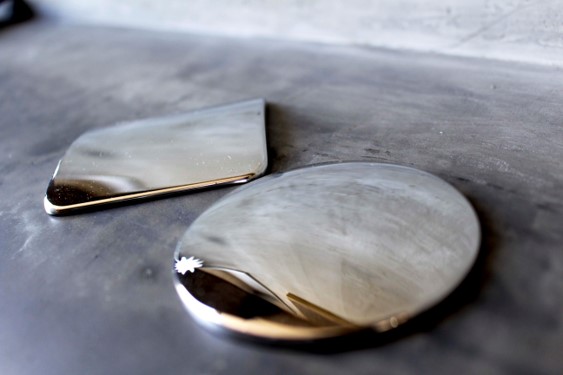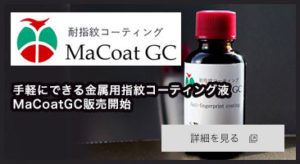One of the polishing processes is called “mirror finishing,” which literally means a processing method to finish the surface of metal like a mirror. However, there are many things that are still unknown, such as the difference between the scope generally recognized and the scope recognized by the metal processing industry.
In this article, we will discuss
“What is a mirror finish?
“What are its characteristics?
“What kind of variations are there?
and “What variations are there?
What is a mirror finish?
A mirror finish is a design polishing finish that gives a mirror-like reflection to the surface of metal. There is a slight difference between the scope of our industry and that of the general public.
Let me explain using a commonly manufactured stainless steel mirror plate.
The products that are generally recognized as having a mirror finish as a finish that reflects the face nicely are
1, Buffing #400

2, Gloss buffing finish #600
3、Buffed mirror finish NO.700
4、Glazed mirror finish NO.8
5、Mirror finish #800
These are the product lines that we have.
In our industry
mirror surface means 3, 4, and 5.
However, in general
1 to 5 are recognized as mirror surface. In particular, #400 mirror polished products are often referred to as “polished”. Therefore, it is better to tell us the purpose of the product when you buy it.
For more information on polishing stainless steel, please see below.
Introduction of mirrored plates of stainless steel, etc.
Why do we polish?
A mirror finish is one in which the surface reflects like a mirror, but it has a wide range of uses depending on the grade and design expression. The higher the grade of the mirror finish, the more difficult it is to repair scratches.
The stainless steel #400 buffing plate is the most widely used of all stainless steel mirror plates, and is widely used for various purposes. This product is a representative of stainless steel surface finishing that has been loved for more than half a century. It has been used in a wide variety of applications, from medical equipment, food equipment, and vehicles to semiconductor manufacturing equipment and display device manufacturing equipment. On the other hand, stainless steel #600 or higher mirror surface plates are widely used for interior and exterior construction and equipment. Of course, the higher the grade, the higher the price. Therefore, it is not possible to use only the highest grade, so customers can choose according to their usage. In the case of highly designed architectural work involving welding process made of stainless steel, #700 is the one that can be reworked. No.8 is recommended if the defective part can be made not to show by technique. However, if you want to use it as a mirror, #800 or more from a flat stainless steel plate with a thickness of 2.0 mm or more is preferable.
In general, SUS304 stainless steel mirror plates are the mainstream, but mirror processing is also possible for stainless steel grades such as SUS316 with high corrosion resistance and SUS430 with chromium, depending on the application. Please consult with us from the design and functional aspects so that we can provide you with the most suitable product.
As for the finishing method and finish of the welded area, stainless steel #400 buffing plate is finished with sisal buffing. After finishing the welded area with a sander, it is raised to about #600 with paper, and then finished with sisal buffing to achieve #400. The point to note here is to match the buffing grain. If the buffing grain is out of alignment, going straight, or facing diagonally, the design will be lost. Please be careful.
For buffing mirror finish of #600 or #700 stainless steel, after finishing to #400, use a surface buffing tool to remove the buff marks and increase the luster. Although it is not necessary to match the buffing grain as much as #4000 buffing, the direction of the buffing grain should still be the same or it will look crossed and mottled due to the reflection.
As for the correction method for stainless steel NO.8 and #800, it requires a lot of technique. This cannot be done with the same grinder that I have used in the past, but with a polisher that rotates in a circular motion. After grinding up to about #700, the final polisher is used to finish the work, but since the liquid is quite special, know-how and technique are required.
Features
Mirror-polished finishes vary in difficulty depending on the grade. Special production methods and equipment are required.
For small items, #400 or so, it is possible to finish them once the technique is relatively mastered. Applicable materials include stainless steel, titanium, aluminum, copper, and brass.
However, there are some finishes that cannot be applied depending on the grade, so we ask for inquiries on a case-by-case basis. In addition, although each facility is different, one of the main features is that we can finish a wide range of shapes, including plates, square pipes, round pipes, channels, angles, and other types of steel, as well as fabricated shapes.
The beautiful mirror-like finish is the basis for creating any design pattern. There are many types of stainless steel mirror sheets, so if you want to reduce reflective pollution outdoors, you can use a low-reflective stainless steel mirror sheet as a base for forming textures. In addition, if you want to add reflection elements, you can choose a stainless steel mirror plate with high resolution.
[Click here for examples.]
For other detailed articles on stainless steel mirror finish, please see the following
variation
Stainless steel mirror finishes are available in a variety of grades, but there is a wide range of design expressions, such as texture formation on the mirror finish, partial design processing, partial coating, and vapor deposition processing. When deburring, which is a process that occurs in metal processing, if the burr bites into the mirror surface, the surface will be blurred, so depending on the shape you want to buy, you may need to select a product that allows post-processing correction or change the processing procedure.
Therefore, depending on the shape you want to buy, you may need to select a product that can be post-processed or change the processing procedure. Since stainless steel mirror-finished plates are materials, you can achieve fast and efficient production by deciding on the grade of stainless steel mirror-finished plates that will be your star and selecting the processing method with the finish in mind, based on the product you want to produce.
Click here to see actual examples of use.
Golden Water Drop
Golden Stainless Steel
Mysterious Stainless Steel Mirror Ripples
JEUX D’EAU
水明(SUIMEI)
Cautions
Stainless steel mirror finish has a very smooth surface. Therefore, it is a very delicate surface finish.
Thanks to its smooth surface roughness, the corrosion resistance is low, but the cleaning is very careful. Cleaning with a sponge or rag containing even a small amount of dust will cause scratches. Furthermore, even if you use clean water, water marks, water stains, and uneven wiping will appear.
Initially, it is a beautiful mirror finish, but for some applications, it may be better to add an extra element.
Incidentally, because of the smoothness of the mirror finish, it is extremely difficult to apply fingerprint resistant coating material such as MaCoat GC, which is handled by our company (subsidiary).
If the surface has an uneven texture, dirt and fingerprints are relatively less noticeable.

[Keep the beautiful design forever
We sell a coating solution that anyone can use to prevent fingerprints easily and simply. The fingerprint resistant coating liquid “MaCoat_GC” can be applied to metal just by applying the liquid. The coated metal is almost invisible to the eye. Since the liquid coating can be applied easily to any shape or location of metal, it is being used in a variety of applications such as three-sided frames of elevators, interior partitions, and artwork. Please contact us directly for purchasing information.
